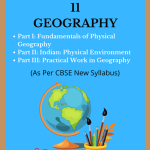NCERT Class 11 Geography Chapter 6 Geomorphic Processes Solutions to each chapter is provided in the list so that you can easily browse through different chapters NCERT Class 11 Geography Chapter 6 Geomorphic Processes and select need one. NCERT Class 11 Geography Chapter 6 Geomorphic Processes Question Answers Download PDF. NCERT Geography Class 11 Solutions.
NCERT Class 11 Geography Chapter 6 Geomorphic Processes
Also, you can read the NCERT book online in these sections Solutions by Expert Teachers as per Central Board of Secondary Education (CBSE) Book guidelines. CBSE Class 11 Geography Solutions are part of All Subject Solutions. Here we have given NCERT Class 11 Geography Part I: Fundamentals of Physical Geography, Part II: Indian: Physical Environment, Part III: Practical Work in Geography. NCERT Class 11 Geography Chapter 6 Geomorphic Processes Notes, NCERT Class 11 Geography Textbook Solutions for All Chapters, You can practice these here.
Geomorphic Processes
Chapter: 6
GEOGRAPY [ PART – I ]
TEXTUAL QUESTIONS ANSWERS
MULTIPLE CHOICE QUESTIONS
1. Which one of the following processes is a gradational process?
(a) Deposition.
(b) Diastrophism.
(c) Volcanism.
(d) Erosion.
Ans. (d) Erosion.
2. Which one of the following materials is affected by hydration process?
(a) Granite.
(b) Clay.
(c) Quartz.
(d) Salts.
Ans. (b) Clay.
3. Debris avalanche can be included in the category of:
(a) Landslides.
(b) Slow flow mass movements.
(c) Rapid flow mass movements.
(d) Subsidence.
Ans. (c) Rapid flow mass movements.
4. What kind of change is bought by internal forces?
(a) It gives birth to new landforms.
(b) It promotes moistures.
(c) Both a and b.
(d) None of the above.
Ans. (a) It gives birth to new landforms.
5. The expansion of the salt depends on
(a) temperature.
(b) hails.
(c) atmospheric pressure.
(d) winds.
Ans. (a) temperature.
6. Which of the following processes is a degradational process?
(a) Deposition.
(b) Diastrophism.
(c) Volcanism.
(d) Erosion.
Ans. (d) Erosion.
7. Rapid rolling or sliding of earth debris without backward rotation of mass is known as
(a) debris slide.
(b) slump.
(c) rockslide.
(d) mudflow.
Ans. (a) debris slide.
8. Which one of the following helps in aerating the soil?
(a) Micro fauna.
(b) Meso fauna.
(c) Macro fauna.
(d) All of the above.
Ans. (b) Meso fauna.
9. Debris avalanche can be included in which category?
(a) Landslide.
(b) Slow flow mass movements.
(c) Rapid flow mass movements.
(d) Subsidence.
Ans. (c) Rapid flow mass movements.
10. The capacity of rocks to allow water to pass through it is called _____________.
(a) porosity.
(b) wedging.
(c) exfoliation.
(d) hydration.
Ans. (a) porosity.
11. Which is the force that continuously elevates or build up parts of the earth’s surface?
(a) Exogenic forces.
(b) Endogenic forces.
(c) Gradation.
(d) Degradation.
Ans. (b) Endogenic forces.
12. Weathering is an important to process for what?
(a) Formation of clouds.
(b) Formation of soil.
(c) Formation of water.
(d) All of the above.
Ans. (b) Formation of soil.
13. Which one of the following materials is affected by the hydration process?
(a) Granite.
(b) Clay.
(c) Quartz.
(d) Salts.
Ans. (d) Salts.
14. What do you mean by all Earth materials having a sloping surface?
(a) Soil erosion.
(b) Landslides.
(c) Volcanism.
(d) Slump.
Ans. (a) Soil erosion.
15. Which of the following is a type of mass movement?
(a) Slow movements.
(b) Rapid movements.
(c) Landslides.
(d) All of the above.
Ans. (d) All of the above.
16. In weathering ___________.
(a) No motion of material takes place.
(b) Materials move from one place to another.
(c) The deposition of material takes place.
(d) None of the above.
Ans. (a) No motion of material takes place.
17. Which of the following is a form of weathering?
(a) Physical.
(b) Chemical.
(c) Biological.
(d) All of the above.
Ans. (d) All of the above.
18. Weathering can be defined as ____________.
(a) Mechanical disintegration of rocks.
(b) Disintegration and deformation of rocks with the help of climatic factors.
(c) Chemical decomposition of rocks.
(d) All the above.
Ans. (d) All the above.
19. Which of the following is an example of endogenic forces?
(a) Erosion.
(b) Volcanism.
(c) Weathering.
(d) Balance.
Ans. (b) Volcanism.
20. What are geomorphic causes of erosion?
(a) Flowing water.
(b) Underground water.
(c) Air.
(d) All of the above.
Ans. (d) All of the above.

Hi! my Name is Parimal Roy. I have completed my Bachelor’s degree in Philosophy (B.A.) from Silapathar General College. Currently, I am working as an HR Manager at Dev Library. It is a website that provides study materials for students from Class 3 to 12, including SCERT and NCERT notes. It also offers resources for BA, B.Com, B.Sc, and Computer Science, along with postgraduate notes. Besides study materials, the website has novels, eBooks, health and finance articles, biographies, quotes, and more.




